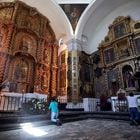Catholic parishioners pray in the Franciscan Conventual Complex, the Monastery and Cathedral of Our Lady of the Assumption, in the State of Tlaxcala.Hilda Ríos / EFE
From Tlaxcala to the world. The smallest state in Mexico has just inscribed the Franciscan monastery and cathedral of Our Lady of the Assumption of Tlaxcala on the UNESCO heritage list. A very special convent considered a vestige in perfect condition of the constructions that were raised after the Conquest of Tenochtitlan.
Built in 1527, the Asunción convent is part of a group of 15 monasteries on the slopes of the Popocatépetl volcano that were built by Franciscan, Dominican and Augustinian monks in the first stage of the arrival of the Spanish. Allies of the Tlaxcalans, the Spanish found facilities to build this type of building with the permission of the native peoples. The Convent of La Asunción is the first building in the region that shows the union between the Renaissance style and the pre-Hispanic elements, which would give rise to the art of New Spain; with exponents such as the majestic church of Huejotzingo, in Puebla."Convents were created from where there were towns or manors to carry out the process of evangelization and also serve to supply food on a strategic route to the north", explains Luz de Lourdes Herbert, director of World Heritage of the Institute National Archeology and History (INAH).
"From the first relationship of the evangelizers with the native peoples, a very particular art and a fundamental construction factory company for the rest of the constructions of the Puebla-Tlaxcala region arises," says the deputy director of World Heritage of the INAH, Francisco Vidargas.
The beauty of the cathedral of Tlaxcala, in pictures
The network of monasteries was recognized in 1994 by UNESCO and the Convent of La Asunción, the current cathedral of Tlaxcala, was yet to be added to the list.
These constructions served as a model for the design of other monasteries and churches in the new Spain that consolidated not only the military conquest of what is now Mexico, but also the spiritual conquest of the native peoples.
The evangelization and construction of these convents also triggered the development of new professions in which new artisans were trained. "The indigenous peoples were instructed in carpentry, sculpture, gilding, goldsmithing, embroidery and blacksmithing that was taken to other convents," says Vidargas. "This made the monasteries of the 16th century one of the most original artistic and architectural contributions of Ibero-American art," adds Luz de Lourdes Herbert.
The architectural ensemble of La Asunción stands out for being a rare convent in many ways. While the rest were built on flat ground, this building was built on a hill and that is why the monks' gardens are on a higher plane than the main atrium. An atrium that forms a space where public and religious life were mixed, bringing the new religious rites closer to the original traditions. "The indigenous people were not in the habit of being inside the roofed spaces and the evangelization work was carried out in this space of the atrium and the open chapel", explains Herbert.
The church is located on a stepped platform with two staircases that lead to the temple and are reminiscent of the basement of the ancient Mexica temples. Although the convent was not built on any ceremonial or sacred center, "there are pre-Hispanic elements in the walls and the basement that tell us not that there were temples, but that there were indigenous labor," says Vidargas.
Another extraordinary element that the complex has is a free-standing tower, also from the 16th century and of which there are only 31 similar bell towers in Mexico.
This is considered the first to be built in the region.
Luz de Lourdes Herbert highlights the unique paneling that protects the roof of the temple.
A coffered ceiling with motifs of white cedar wood of Mudejar heritage, considered one of the most important in Latin America and dating from the seventeenth century.
Tlaxcala, the first reticular city of New Spain, is an example of an architectural model that provided a solution to the new social and cultural context of the time.
The convent of the Assumption and its design influenced the urban development of the monasteries of the 18th century, centers of religious, social and cultural life.
Subscribe here
to the
newsletter
of EL PAÍS México and receive all the informative keys of the current situation of this country

